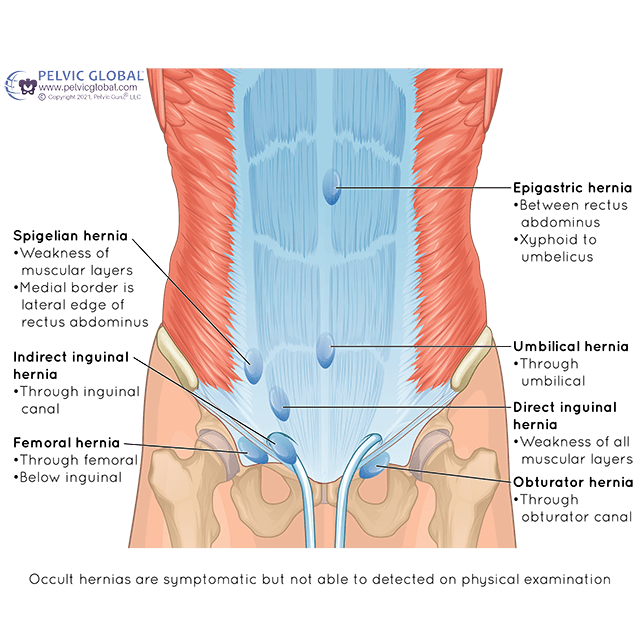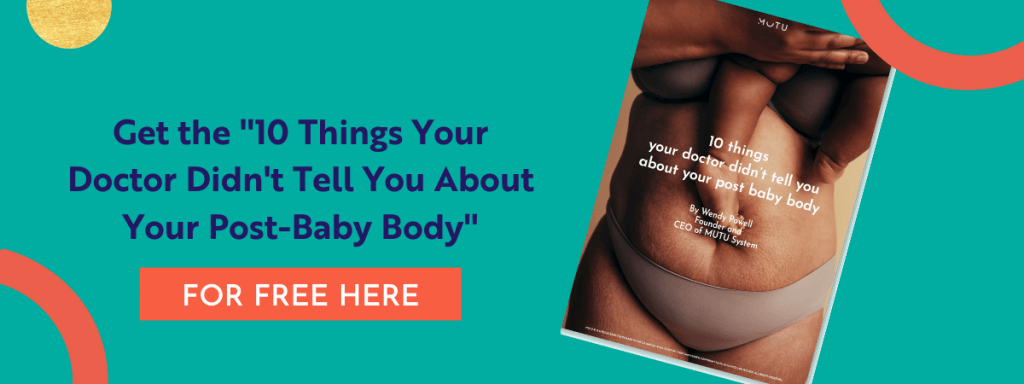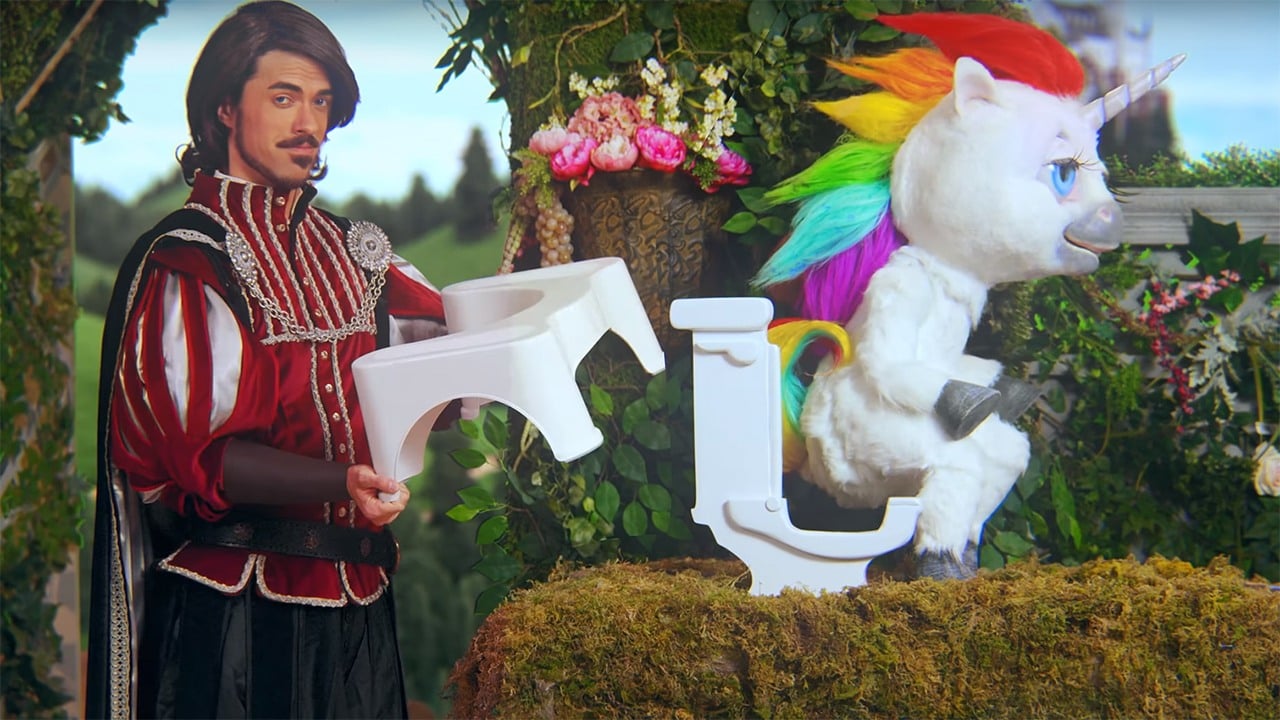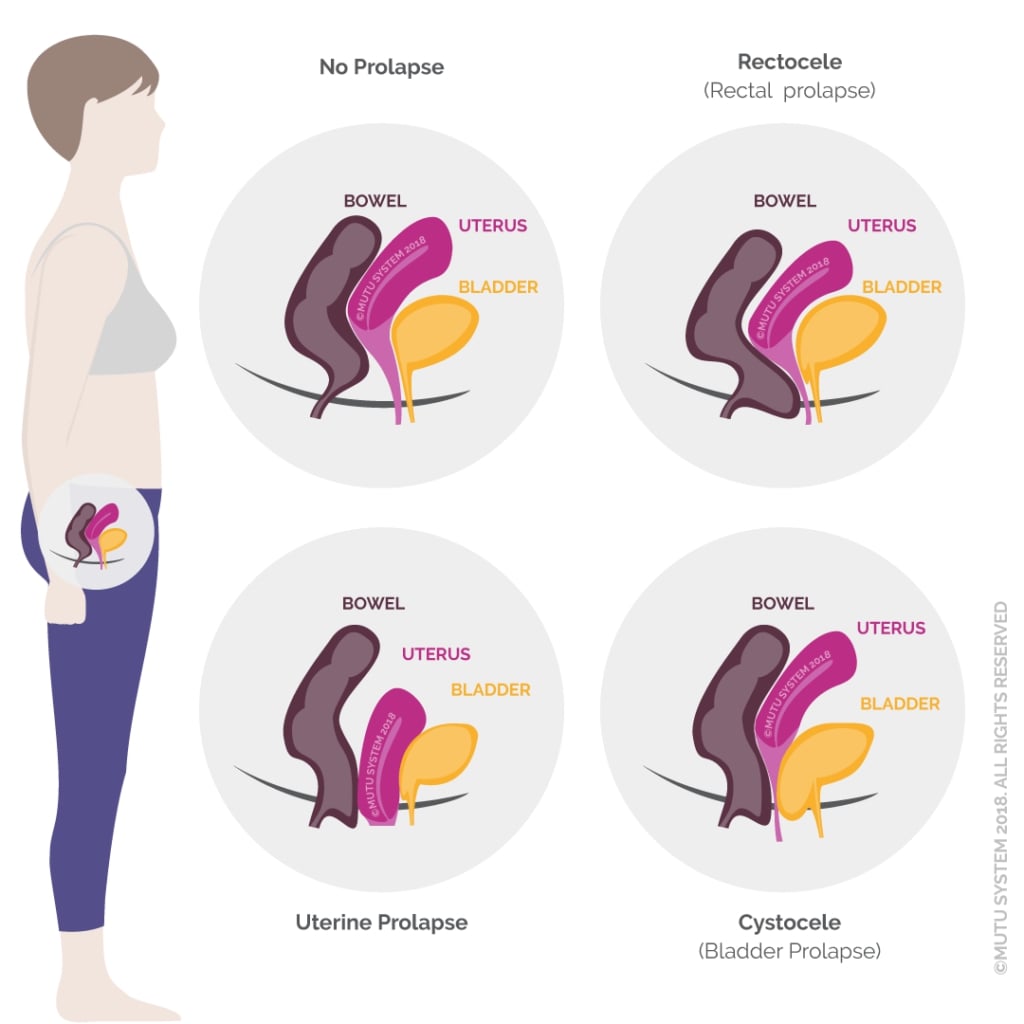
Postpartum umbilical hernia, diastasis recti, and prolapse actually all have a related root cause. They stem from pressure inside your abdomen and/or pelvis, that is under stress. This pressure can build up due to alignment or postural factors.

Hernia describes where a bit of your body that should be inside (like part of your intestine or bowel) actually pokes out through your abdominal wall. Not like, out through your skin, ‘out’. Out through a layer of internal tissue, so you see a lump, ‘out’.
There are different types of hernia but the one most likely to affect women during or after pregnancy is an umbilical hernia. This means a hernia located at or near your belly button (umbilicus).
An incisional hernia is another type of hernia which can sometimes occur after surgery of the abdomen (such as c-section).
How do I know if I have a hernia?
You will see a bulge, or an outie belly button, or a thumb-shaped protrusion. There may be a soft swelling, possibly with a dark tint to the skin in the area. It may feel tender to touch, you may be able to gently push it back in sometimes. You may be more aware of it when you strain (lifting something heavy, or coughing or sneezing).

What causes it?
A hernia, like diastasis recti or prolapse, is caused by excessive intra abdominal pressure. That’s pressure inside your abdomen and pelvis, that is pushing away (outwards).
Some factors which can contribute are: multiple pregnancies or obesity, as well as straining, heavy lifting, or violent or prolonged coughing.
But having more than a couple of babies, or moving heavy furniture around or coughing don’t cause hernia on their own.
Umbilical hernia occurs when your alignment or core function isn’t quite optimal. And this can happen because of postural and load shifts during and after pregnancy. Like a kinked hose-pipe or an over-squeezed balloon, eventually something’s got to give, and the result is the hernia popping out.
Should I get surgery for postpartum umbilical hernia?
Surgery is often not considered necessary for a small umbilical hernia. It is really dependent on whether the hernia is causing you distress or pain, or is getting bigger. ‘Strangulation’ of a hernia can cause more serious problems, however.
Surgery to repair a hernia is relatively common. The surgeon will push the offending protruding part back where it belongs, and then sew up the hole. Laparoscopic surgery or open repair using sutures (without mesh) is known as ‘primary closure’.
Some procedures use a surgical mesh to reinforce the abdominal wall. Surgical mesh is also used in some incontinence and pelvic organ prolapse surgeries, but this has involved significant controversy.
The issue is not too much pressure inside your abdomen – it’s supposed to be there – the issue is that your core muscle system is not able to stabilise the pressure correctly. It’s kinked. Like the hosepipe. So even if you have surgery to close the hole and reverse the hernia, the pressure problem inside can still be there.
Remember too, that surgery is fixing the symptom (the visible hernia) but has not addressed the cause (the pressure, or the core weakness). You should still follow alignment and core strengthening strategies to avoid a recurrence.
Alignment adjustments to relieve hernia symptoms
‘Alignment’ in this context means the way you carry your body every day. The way your body is biomechanically stacked, head on shoulders, on ribs on pelvis. All the way down to your feet and the shoes you wear. How your body is positioned as you stand, sit, or walk determines how effectively your core muscle system can stabilise and hold everything where it’s supposed to be.

There are some very common movement habits which compromise this alignment ‘mismatch’ and prevent the core muscles from functioning correctly to do this.
Untuck your tailbone
Many of us tend to walk and stand with our backside slightly clenched, effectively flattening our bum and pushing our pelvis forward. This position compromises our core’s ability to contain pressure effectively. Try at first just noticing if you do this, and remind yourself as often as you can to unclench and untuck, letting your bum sit high and proud, like bums are supposed to.
Change your shoes
The heel height of your shoes forces your body to compensate for the angle and keep you upright, creating a pelvic thrust and tilt. Your core muscles are simply not in an optimal position to do their job and contain intra abdominal pressure effectively. It doesn’t mean high heels must be abandoned entirely, but give your feet plenty of opportunities to have full contact with the ground and your toes room to wiggle and spread.
Feet face forward!
Do your feet turn outward as you stand or walk? This can have the effect of forcing a flattened bum and a tucked tailbone. Keep checking in on the direction your feet are facing, and try to adjust your alignment to straighten them up and let your glutes work properly.
The added bonus of the above adjustments is that your bum will look better! A flat bum is a friend to no woman… and just a few minor, ongoing adjustments to your alignment can have the effect of switching those glutes back on.

Exercises to avoid if you have umbilical hernia
Some moves will strain and exert further pressure on your abs and pelvic floor and should be avoided if you have an umbilical hernia. Stay away from crunches or sit-ups, and be aware of breath holding or straining when you work out.
Safe exercise for umbilical hernia after pregnancy
MUTU System is the online, medically recommended exercise and recovery program. Daily practice is for only 15-20 minutes with step-by-step instructions. It will help you strengthen your core and pelvic floor, lose weight, and feel confident and great again. MUTU focuses on strengthening and realigning your core and whole body posture to reduce this pressure, as well as relieve back pain and improve core muscle function.
Includes comprehensive modifications, strategies and resources to address umbilical hernia after pregnancy and associated issues.

Further resources & links
Downloadable (free) PDF information leaflets and very helpful diagrams available from the International Urogynecological Association (IUGA) (click ‘Patient Leaflets’)
WebMD on umbilical hernia in adults
Medical papers / more technical:
NCBI / PubMed on umbilical hernia repair







I have pain in my knees from doing lunges and my orthopedic advised me not to do them, will the squats in the program be bad for my knees?
Hi RefluxMD, There is a full video section of modifications for exercises in the program, along with detailed demonstrations of how to squat or lunge in good technique and to avoid injury.
Hi, I’m 12 weeks postpartum with my 2nd child. They’re only 20 months apart. I have an umbilical hernia from the first pregnancy, and it got more pronounced during the second. I also have diastasis recti. I still look pregnant. I haven’t started the MuTu system yet, but I was wondering when should I start seeing a difference after starting the program. My OBGYN said I’d probably have to have the hernia surgically repaired, but I’d like to avoid that if possible. Thanks for any help you can offer.
Hi Crystal, yes MuTu will be able to help you but I would also strongly recommend you follow the program alongside complimentary care from a specialist womens’ health physical therapist to help you adapt or moderate as appropriate to your personal situation (how to find one here https://mutusystem.com/referral-to-a-womens-health-physiotherapist
Hi I am 28 weeks pregnant. I had an umbilical hernia when I was a child and had it removed about the age of 5.. I went to the doc and can’t have a cat scan due to my pregnancy … I have had pain before but this “phantom pain” from the hernia site and extends to my side is absolutely HORRIBLE! I can’t stand or walk .. even breathing hurts… I woke up about 30 min ago in pain and took Tylenol.. I don’t know if my child is where my hernia was or what to do the pain is getting unbearable and there is NOTHINF I CAN DO
Hi Lakin,
I’d recommend you ask your doctor for a referral to a Women’s Health Physiotherapist. Find out more about being referred here: https://mutusystem.com/referral-to-a-womens-health-physiotherapist
Hi! I got diastasis recti and a small umbilical hernia after having my daughter who is 4 months now. I have been doing a few exercises to relieve symptoms and my hernia is barely visible. Should I go through with the surgery to repair the hernia or should I wait until I have healed from diastasis? Thanks
Hi Karina. Unfortunately we cannot advise either way. We are’t medically trained therefore you need to speak with your doctor or specialist about the best course of action for you. Above in this article are non-surgical techniques but you would need to get the okay from your doctor first.
Can a women still have a baby after her hernia in her navel has been removed
I had an emergency appendectomy and before surgery I told the surgeon that my umbilical hernia had disappeared and I was concerned. I had the surgery and the surgeon did a patch up of the fascia and sewed me up however because it was at the same time of the appendectomy he did not place a mesh, to avoid possible infection. So, after the surgery I felt like a new person. My abdomen looked so different and my belly button was back (it used to look like it had a tongue hanging out, pardon the harsh reality) Anyway, immediately after the surgery when I went home I was walking up the stairs at home and I noticed I could breathe so much easier, I wasn’t as out of breath as before. I hadn’t lost any weight in the surgery and there wasn’t any cosmetic work done. I am currently overweight but not so much to make me as winded as I had been prior to the surgery and I feel like when he fixed my hernia it pulled all of my abdomen back in I didn’t have that heavy weight hanging so I could breathe easy. My question is, can an umbilical hernia cause breathing issues? The surgeon said that his stitching was a temporary job for the hernia because I would need to have a mesh placed to prevent it from happening again. Unfortunately 2 months after the surgery my hernia is poking through again and I can feel it fall, the hanging tongue look is back and it’s harder to breathe again. Could this hernia and the difficulty breathing be related? (I have had 3 pregnancies with huge babies and the hernia was due to the pregnancies, most recent birth was 2 years ago and that was the one that did me in) Your thoughts, advice would be appreciated.
I had an emergency appendectomy and before surgery I told the surgeon that my umbilical hernia had disappeared and I was concerned. I had the surgery and the surgeon did a patch up of the fascia and sewed me up however because it was at the same time of the appendectomy he did not place a mesh, to avoid possible infection. So, after the surgery I felt like a new person. My abdomen looked so different and my belly button was back (it used to look like it had a tongue hanging out, pardon the harsh reality) Anyway, immediately after the surgery when I went home I was walking up the stairs at home and I noticed I could breathe so much easier, I wasn’t as out of breath as before. I hadn’t lost any weight in the surgery and there wasn’t any cosmetic work done. I am currently overweight but not so much to make me as winded as I had been prior to the surgery and I feel like when he fixed my hernia it pulled all of my abdomen back in I didn’t have that heavy weight hanging so I could breathe easy. My question is, can an umbilical hernia cause breathing issues? The surgeon said that his stitching was a temporary job for the hernia because I would need to have a mesh placed to prevent it from happening again. Unfortunately 2 months after the surgery my hernia is poking through again and I can feel it fall, the hanging tongue look is back and it’s harder to breathe again. Could this hernia and the difficulty breathing be related? (I have had 3 pregnancies with huge babies and the hernia was due to the pregnancies, most recent birth was 2 years ago and that was the one that did me in) Your thoughts, advice would be appreciated.
I have 4 kids ranging in age from 20-5 years, got the hernia with kid #3 now age 13, forgot I had it until my last pregnancy, Now 5 years later, it doesn’t majorly bother me, it is difficult to do some stomach exercises so I have to be aware, but for the most part, it is an in-y again but no longer “cute” looks like a blinking eye lol. I would like to have it fixed, or at least the blinking, but the doctors always say just wait, and no one but my man sees it, so as I loose 20 years and 4 kids worth of baby weight, if it “blinks” worse I might have it done just so the skin can breath properly, not so much for the hernia, because like I said, I keep forgetting it is there.
I have 4 kids ranging in age from 20-5 years, got the hernia with kid #3 now age 13, forgot I had it until my last pregnancy, Now 5 years later, it doesn’t majorly bother me, it is difficult to do some stomach exercises so I have to be aware, but for the most part, it is an in-y again but no longer “cute” looks like a blinking eye lol. I would like to have it fixed, or at least the blinking, but the doctors always say just wait, and no one but my man sees it, so as I loose 20 years and 4 kids worth of baby weight, if it “blinks” worse I might have it done just so the skin can breath properly, not so much for the hernia, because like I said, I keep forgetting it is there.
My OBGYN suggested my umbilical hernia would simply go back down after the twins were born. They are now 6mths old and while I have zero pain, I still have an ugly protruding belly button. Is there hope it may still go down, if so, how long does it usually take? And if not, should I be looking into surgery even if there is no pain involved?
My OBGYN suggested my umbilical hernia would simply go back down after the twins were born. They are now 6mths old and while I have zero pain, I still have an ugly protruding belly button. Is there hope it may still go down, if so, how long does it usually take? And if not, should I be looking into surgery even if there is no pain involved?
My OBGYN suggested my umbilical hernia would simply go back down after the twins were born. They are now 6mths old and while I have zero pain, I still have an ugly protruding belly button. Is there hope it may still go down, if so, how long does it usually take? And if not, should I be looking into surgery even if there is no pain involved?
Please consult with a medical professional as soon as possible regarding any pain Nene – we can’t advise or diagnose!
Please consult with a medical professional as soon as possible regarding any pain Nene – we can’t advise or diagnose!
Can I get mine fixed if I’m 20 wks pregnant? This is my 3rd baby and the hernia is causing so much pain and discomfort now!
Can I get mine fixed if I’m 20 wks pregnant? This is my 3rd baby and the hernia is causing so much pain and discomfort now!
MuTu Focus is recommended to help ease symptoms, but you need to consult a Doctor regarding ‘fixing’ anything Shelby, especially during pregnancy + especially if you are in pain please do this right away!
Can I get mine fixed if I’m 20 wks pregnant? This is my 3rd baby and the hernia is causing so much pain and discomfort now!
MuTu Focus is recommended to help ease symptoms, but you need to consult a Doctor regarding ‘fixing’ anything Shelby, especially during pregnancy + especially if you are in pain please do this right away!
Hi Wendy! I am so very interested in your system but I’m not sure what order to do it in. I do have diastasis recti and an umbilical hernia which has been very uncomfortable for me. Would you recommend doing hernia surgery first then mutu?
Hi Wendy! I am so very interested in your system but I’m not sure what order to do it in. I do have diastasis recti and an umbilical hernia which has been very uncomfortable for me. Would you recommend doing hernia surgery first then mutu?
Consult with your doctor regarding any surgery. MuTu Focus (not 12 Week, you shouldn’t do the Intensive workouts at all) may compliment treatment before or after surgery but your Doctor will be able to advise for your individual circumstances
Hi Wendy! I am so very interested in your system but I’m not sure what order to do it in. I do have diastasis recti and an umbilical hernia which has been very uncomfortable for me. Would you recommend doing hernia surgery first then mutu?
Consult with your doctor regarding any surgery. MuTu Focus (not 12 Week, you shouldn’t do the Intensive workouts at all) may compliment treatment before or after surgery but your Doctor will be able to advise for your individual circumstances
I have pain in my knees from doing lunges and my orthopedic advised me not to do them, will the squats in the program be bad for my knees?
I have pain in my knees from doing lunges and my orthopedic advised me not to do them, will the squats in the program be bad for my knees?
If you have been told by a Doctor to avoid certain movements then please follow that advice. I would recommend you ask him / her regarding squats as it will depend on your individual diagnosis.
I have pain in my knees from doing lunges and my orthopedic advised me not to do them, will the squats in the program be bad for my knees?
If you have been told by a Doctor to avoid certain movements then please follow that advice. I would recommend you ask him / her regarding squats as it will depend on your individual diagnosis.
Hi I have 2 kids my oldest going to be 6 and my baby she just turn 3 I just hade a umbilica hernia repair surgery but my muscles are very week I a have díastasis recti my belly has this weird shape no matter how much I tried to lose weight it always seems like if I’m pregnant I want to restored my abdominal muscles if u guys can help me it will be awesome I want to do this to feel better about my self and my body and better health
The Focus program would be the one to go for Erika. Gentle core restoration + recovery.
Hi I have 2 kids my oldest going to be 6 and my baby she just turn 3 I just hade a umbilica hernia repair surgery but my muscles are very week I a have díastasis recti my belly has this weird shape no matter how much I tried to lose weight it always seems like if I’m pregnant I want to restored my abdominal muscles if u guys can help me it will be awesome I want to do this to feel better about my self and my body and better health
The Focus program would be the one to go for Erika. Gentle core restoration + recovery.
Hi, I have two children and was completely fed up and depressed that I still looked 6 months pregnant. A holiday in Disney land was the last straw, where I was advised in 5 different rides that I should not continue in my condition! I know the staff were only doing their job, but it did ruin the holiday for me 🙁 my wonderful GP referred me for physio that didn’t gave any effect. I returned to my GP some months later and after she examined me again, she referred me to an abdominal surgeon with diastis recti/ possible hernia. The surgeon confirmed a ventral/umbilical hernia. I had surgery December 2013 and all is going well and healing nicely. Now that my abs are back in the correct place, Would your MuTusystem be good for me to now tone up my core? Obviously I wouldn’t want to undo the good work of the surgery.
Thanks for your time and feedback
Yes – its perfect to hep you reconnect, restore + then strengthen those muscles – see the FAQ pages for more help on post-surgery + hernia https://mutusystem.com/faq.html
Hi, I have two children and was completely fed up and depressed that I still looked 6 months pregnant. A holiday in Disney land was the last straw, where I was advised in 5 different rides that I should not continue in my condition! I know the staff were only doing their job, but it did ruin the holiday for me 🙁 my wonderful GP referred me for physio that didn’t gave any effect. I returned to my GP some months later and after she examined me again, she referred me to an abdominal surgeon with diastis recti/ possible hernia. The surgeon confirmed a ventral/umbilical hernia. I had surgery December 2013 and all is going well and healing nicely. Now that my abs are back in the correct place, Would your MuTusystem be good for me to now tone up my core? Obviously I wouldn’t want to undo the good work of the surgery.
Thanks for your time and feedback
Yes – its perfect to hep you reconnect, restore + then strengthen those muscles – see the FAQ pages for more help on post-surgery + hernia https://mutusystem.com/faq.html
I have all three issues listed in this article. Took a lot of doctors,3 years and feeling “crazy” to get some answers. First time I’ve seen anything written will all of these put together. Thank you.
I have been running before,during & after my two girls were born. Stopped any ab work and boot camp like stuff to have have anymore damage done.
abs are very weak now and lower back pain at times,I would like to start this new class called Pure Barre that is low impact,core work and stretching (all which I NEED) Your thoughts?
I thought that if I at least made the muscles strong it could “hold” what “things” it is holding in better,lol.
Not sure why pregnancies (had it with first then C-section with 2nd) caused this. Not overweight,workout…bad luck I guess! But got two healthy babies 😉
Thanks for any info.
I’m so happy you found the information helpful. Our programs incorporate the workouts your need, but always with your core weakness + instability in mind – they are safe + effective – you can see how to choose the right one here https://mutusystem.com/download-the-mutu-system-coaching-programme.html
Sorry to butt in on your question as to why a c section and normal pregnancy would cause this – a hormone is released during pregnancy and birth that relaxes the ligaments and tendons throughout the body. So, when the tendons are weak and the muscles aren’t up to par after birth, this tends to cause a jumble for the organs. I’m not sure if Mrs. Powell suggests this in her program ( I’m going to try the program out after I talk with my doc) but the addition of collagen type 1&3 and glucosamine with chondroiton would help to restrengthen ligaments and tendons along with proper exercise. Wish I had followed my own advice, but I didn’t want to take any supplements for fear of what it may do to my breast milk.
I have all three issues listed in this article. Took a lot of doctors,3 years and feeling “crazy” to get some answers. First time I’ve seen anything written will all of these put together. Thank you.
I have been running before,during & after my two girls were born. Stopped any ab work and boot camp like stuff to have have anymore damage done.
abs are very weak now and lower back pain at times,I would like to start this new class called Pure Barre that is low impact,core work and stretching (all which I NEED) Your thoughts?
I thought that if I at least made the muscles strong it could “hold” what “things” it is holding in better,lol.
Not sure why pregnancies (had it with first then C-section with 2nd) caused this. Not overweight,workout…bad luck I guess! But got two healthy babies 😉
Thanks for any info.
I’m so happy you found the information helpful. Our programs incorporate the workouts your need, but always with your core weakness + instability in mind – they are safe + effective – you can see how to choose the right one here https://mutusystem.com/download-the-mutu-system-coaching-programme.html
Sorry to butt in on your question as to why a c section and normal pregnancy would cause this – a hormone is released during pregnancy and birth that relaxes the ligaments and tendons throughout the body. So, when the tendons are weak and the muscles aren’t up to par after birth, this tends to cause a jumble for the organs. I’m not sure if Mrs. Powell suggests this in her program ( I’m going to try the program out after I talk with my doc) but the addition of collagen type 1&3 and glucosamine with chondroiton would help to restrengthen ligaments and tendons along with proper exercise. Wish I had followed my own advice, but I didn’t want to take any supplements for fear of what it may do to my breast milk.
hello
hello
It has been over 2 yrs since I had my baby. Can I still “get fixed” with your program?. I have a mild prolapse and horrible posture….not what I used to be. Will my organs go back in place now after so long?
You can always make improvements to your core stability + strength, + no program can or should claim to ‘cure’… However we have many. many success stories with situations such as yours – please see this page for more info on when additional medical help is recommended https://mutusystem.com/referral-to-a-womens-health-physiotherapist.html + this page for video testimonials https://mutusystem.com/video-testimonials.html
It has been over 2 yrs since I had my baby. Can I still “get fixed” with your program?. I have a mild prolapse and horrible posture….not what I used to be. Will my organs go back in place now after so long?
You can always make improvements to your core stability + strength, + no program can or should claim to ‘cure’… However we have many. many success stories with situations such as yours – please see this page for more info on when additional medical help is recommended https://mutusystem.com/referral-to-a-womens-health-physiotherapist.html + this page for video testimonials https://mutusystem.com/video-testimonials.html
I found this website really helpful and appreciated the further reading on the topic.
Thanks. I’m only 7 weeks post partum and having my suspected hernia checked this week. My tummy is normally my pride and joy and I want to do everything I can to make it look better now. I feel a lot more confident that something can be done through the right exercise. Thanks again!!
I found this website really helpful and appreciated the further reading on the topic.
Thanks. I’m only 7 weeks post partum and having my suspected hernia checked this week. My tummy is normally my pride and joy and I want to do everything I can to make it look better now. I feel a lot more confident that something can be done through the right exercise. Thanks again!!
I’m glad it helped Nicky 🙂
I found this website really helpful and appreciated the further reading on the topic.
Thanks. I’m only 7 weeks post partum and having my suspected hernia checked this week. My tummy is normally my pride and joy and I want to do everything I can to make it look better now. I feel a lot more confident that something can be done through the right exercise. Thanks again!!
I’m glad it helped Nicky 🙂